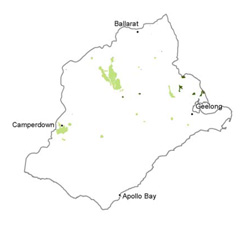38 Red sodic and non-sodic texture contrast soils on Quaternary basic volcanics
| These soils occur on basic volcanic deposits including ash deposits in slightly better drained areas (such as footslopes of eruption points) and slightly stony plains in the drier eastern part of the volcanic plains (where they are sodic soils with many strongly sodic occurrences). The soils in the drier areas have a dark structured clay loam (to 20 cm) sharply changing to a coarse strongly structured hardsetting red heavy clay with increasing stone (parent material) with depth grading into parent material at 70–100 cm. There may be calcareous material present in the lower subsoil as with other basaltic soils in the drier areas of the basic volcanic plains. In the moister areas the soils would be more acidic and a subsurface horizon may be more prevalent and bleached, abruptly overlying the heavy subsoil. No mottling and brighter, denser colours would imply better drainage. Notable characteristics include: texture contrast, variable depth of surface soil (often limited), hardsetting coarse structure of subsoil where strongly sodic, variable stone content (can be moderately stony), moderately deep (60–100 cm) to deep (>100 cm), alkaline soils in drier areas (often with free carbonate at depth). |  |
Soil Sites
Site Code | Soil-landform unit | Component | ASC | FK | 1:100 000 mapsheet |
MM5075 | Mid slope | Melanic, Mesonatric, Red Sodosol | Dr4.13 | T7721 - Geelong | |
| Mid slope | Melacic, Mesotraphic, Red Chromosol | Dr2.11 | T7722 - Bacchus Marsh |


